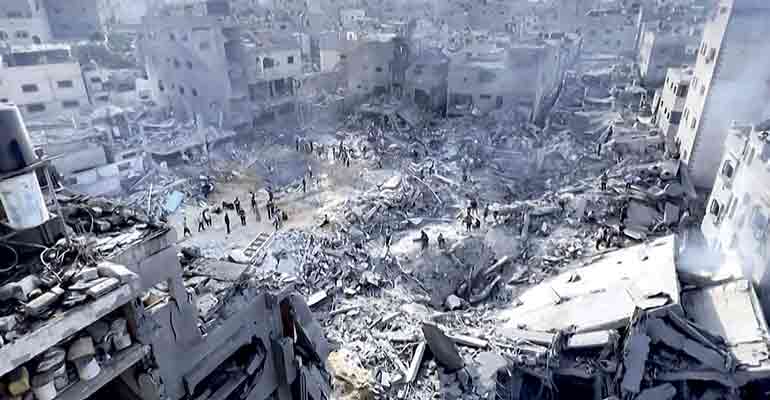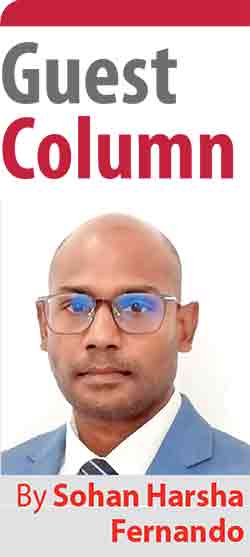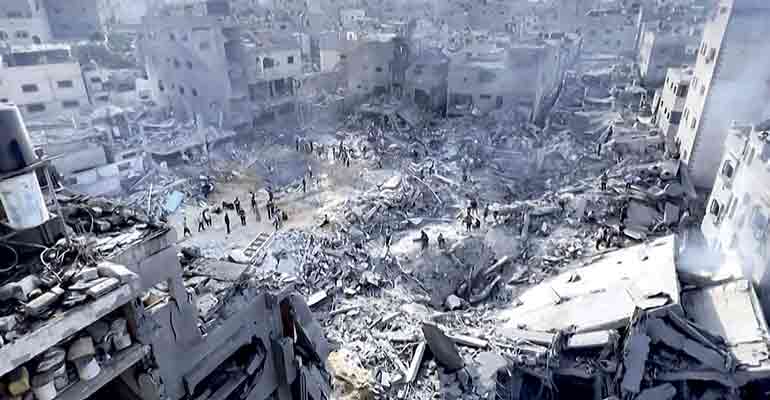Thursday Oct 23, 2025
Thursday Oct 23, 2025
Thursday, 23 October 2025 00:12 - - {{hitsCtrl.values.hits}}

The central framing battle is this: is a Palestinian firing a rocket an act of “terrorism” or an act of “resistance” against a military occupation?
To understand the conflict in Palestine today, you must look beyond the headlines of the latest explosion and what’s happening in Gaza, because Gaza is the result but not the ultimate goal. You must trace a decades-long project—a deliberate and powerful reframing of a struggle for land into a battle against terror. This is the story of how a national liberation movement was systematically recast in the costume of a global existential threat, and how that narrative became unshakable dogma in the halls of Western power.
Part 1: The intellectual blueprint (1970s-1980s)
 The story begins not with a gun, but with a book. In the late 1970s, Benjamin Netanyahu, then a rising star in Israeli diplomacy, was a key figure at the Jonathan Institute, a think tank named after his brother, a fallen war hero. The institute’s mission was to redefine terrorism for the Western world, and its success lay in masterfully aligning its goals with the dominant geopolitical paradigm of the era: The Cold War.
The story begins not with a gun, but with a book. In the late 1970s, Benjamin Netanyahu, then a rising star in Israeli diplomacy, was a key figure at the Jonathan Institute, a think tank named after his brother, a fallen war hero. The institute’s mission was to redefine terrorism for the Western world, and its success lay in masterfully aligning its goals with the dominant geopolitical paradigm of the era: The Cold War.
The central argument presented at the Institute’s 1979 conference was that the Soviet Union was the chief architect of international terrorism. In this framing, groups like the Palestine Liberation Organisation (PLO) were not independent nationalist movements but proxy forces in a Kremlin-directed campaign to destabilise Western democracies and their allies. This was a strategic masterstroke. By tethering the Palestinian struggle to the West’s primary existential threat, the Institute’s narrative accomplished two key things: it delegitimised Palestinian nationalism as a mere Soviet tool, and it solidified Israel’s position as an indispensable “strategic asset”— the democratic front line in the Cold War struggle for the Middle East.
However, the collapse of the Soviet Union in 1991 created a strategic vacuum. The West, and particularly the vast US national security apparatus and the defence industry that supplied it, faced what commentators called a “peace dividend” or a “threat deficit”. The institutional machinery built over decades for a global confrontation required a new, compelling rationale for sustained high levels of military spending and global engagement.
It was at this precise moment that the intellectual blueprint of the Jonathan Institute proved its enduring utility. The framework could be seamlessly adapted. The enemy was no longer the “Soviet bloc,” but what thinkers like Netanyahu termed “radical Islamism” or “the enemies of civilisation.” In his 1995 book, Fighting Terrorism, he argued that this new, diffuse threat was equally, if not more, dangerous than the old state-based adversary. The Palestinian resistance, particularly its Islamist factions like Hamas, could now be recast not as a nationalist movement, but as a local manifestation of this new global jihad.
This post-Cold War shift was not merely ideological; it was deeply institutional. The “War on Terror”, declared after the attacks of 9/11, became the full-scale realisation of this adapted blueprint. It provided a renewed sense of mission and justification for defence budgets,
military interventions, and a security-first foreign policy. The complex reality of occupation was thus submerged beneath the simplistic and powerful narrative of a civilisational war, narrative that served the strategic interests of multiple actors simultaneously.
Part 2: The new world order and a new enemy (1990s)
With the collapse of the Soviet Union in 1991, the framework needed a new antagonist. The void was filled by the concept of “Islamist extremism”. In his 1995 book, Fighting Terrorism, Netanyahu solidified this shift. The conflict was no longer about borders or occupation; it was a battle between “the world of freedom” and “the world of fear”. This rhetorical move was strategic genius. It elevated the Israeli-Palestinian conflict from a messy regional dispute to a front line in a global struggle, instantly aligning Israel’s interests with those of the sole superpower, the United States.
This alignment did not happen by accident. It was engineered through one of the most effective political machines in Washington: AIPAC (the American Israel Public Affairs Committee). AIPAC mastered the art of bipartisan influence, ensuring that unwavering support for Israel was a non- negotiable pillar of US foreign policy. Through lobbying, campaign donations, and a powerful network of allies, it made criticism of Israel politically costly. The result was a steady stream of American military aid—now over $ 3.8 billion a year—and a reliable US veto at the UN Security Council, shielding Israeli policies from international accountability.
Part 3: The perfect storm (2000s–present)
The ideological blueprint, however, required a catalyst to become a self-perpetuating reality. That catalyst arrived on 11 September, 2001. The attacks did not just cause national trauma; they created a political environment where the pre-existing narrative could be activated with overwhelming force. The complex origins of the 9/11 hijackers—15 of the 19 were citizens of Saudi Arabia, and their leader, Osama bin Laden, was motivated by a mix of extremist ideology and grievances with US policy in the Middle East—were instantly simplified into a single, usable truth: the West was under existential attack from Islamist terror.
The US response, the declaration of a global “War on Terror”, was the moment the blueprint was put on steroids. As commentators like Tucker Carlson have pointed out in retrospect, 9/11 became the ultimate justification for the unchecked growth of the national security state. The 2001 Authorisation for Use of Military Force (AUMF) effectively granted a blank check for perpetual war, not against a specific nation, but against a vague and endlessly adaptable concept of “terror”.
This had two profound consequences:
1. The unleashing of the military-industrial complex: Defence budgets skyrocketed, launching what critics describe as a state of permanent, profit-driven conflict. The “War on Terror” became a multi-trillion-dollar enterprise, enriching contractors and creating an entire ecosystem with a vested interest in continuous warfare.
2. The strategic amalgamation of threats: This was the masterstroke. The war’s vague boundaries allowed the US and its allies to seamlessly fold existing conflicts, especially the Israeli-Palestinian struggle, into the new global framework. Hamas and other groups were no longer primarily nationalist resistance movements; they were officially re-designated as regional branches of the same terror network that had hit New York and Washington. This provided Israel with unparalleled diplomatic insulation. Criticism of its policies could now be framed as disloyalty in a civilisational war, a failure to stand with an ally against the very evil that had attacked the homeland.
The “perfect storm” was thus complete: a pre-existing intellectual framework, a catalysing
event of horrific scale, and a powerful machinery of state and corporate interest that benefited from its implementation. The specific, territorial conflict of Palestine was
strategically absorbed into a global narrative, ensuring that the reality of occupation would be perpetually overshadowed by the spectre of terror.
The attacks of 9/11 were a tragic catalyst. The “War on Terror” declared by President George W. Bush dovetailed perfectly with the Netanyahu framework. The world was now officially divided into “with us or with the terrorists”. This binary thinking was weaponised against the Palestinian cause. Groups like Hamas, which combined nationalist goals with Islamist rhetoric, could now be seamlessly integrated into the global boogeyman of “Al-Qaeda”. Their resistance to occupation was systematically rebranded in Western media and politics as mere “terrorism”.

This narrative was fortified by the rise of actual jihadist groups like ISIS, which, despite having no operational ties to Palestine, served the narrative perfectly. Conspiracy theories claiming Mossad or CIA involvement in their creation, while lacking evidence, persist because they speak to a deeper truth: these groups’ existence benefited the narrative that the entire region was a breeding ground for an irrational, civilisation-hating ideology. The complexity of the Palestinian fight for self-determination was buried under the simplistic and terrifying label of “Islamic terrorism”.
Part 4: The on-the-ground reality: Occupation and resistance
While the narrative was being built in Western think tanks and capitols, a very different reality was unfolding on the ground. Since 1967, Israel has maintained a military occupation of the West Bank and Gaza, considered illegal under international law. This occupation is characterised by:
From this perspective, the violence that emerges is not the start of the problem, but a response to it. The central framing battle is this: is a Palestinian firing a rocket an act of “terrorism” or an act of “resistance” against a military occupation? The answer you give depends entirely on which story you believe.
The matrix of power
The situation today is not a simple conflict. It is a matrix where a potent narrative, immense political power, and a brutal on-the-ground reality reinforce each other.
1. The narrative (“It’s a war on terror”) justifies…
2. The political power (unconditional US support and aid), which enables…
3. The on-the-ground reality (permanent occupation and settlement expansion), which in turn fuels…
4. The resistance (some peaceful, some violent), which is then used to reinforce…
5. The narrative (see? It’s terrorism).
To break this cycle, one must first recognise the matrix itself. It requires disentangling the legitimate security concerns of Israelis from the project of permanent occupation and distinguishing the legitimate aspirations of Palestinians for freedom from the warped ideology of extremist groups. The first step is to see the narrative not as an objective truth, but as a powerful political weapon, decades in the making.
(The author is a doctoral candidate specialising in trade economics and a strategic business analyst with extensive experience in international markets, including Russia and Asia. His research, which includes over 11 published papers, often focuses on how nations can navigate complex international systems and sanctions.)